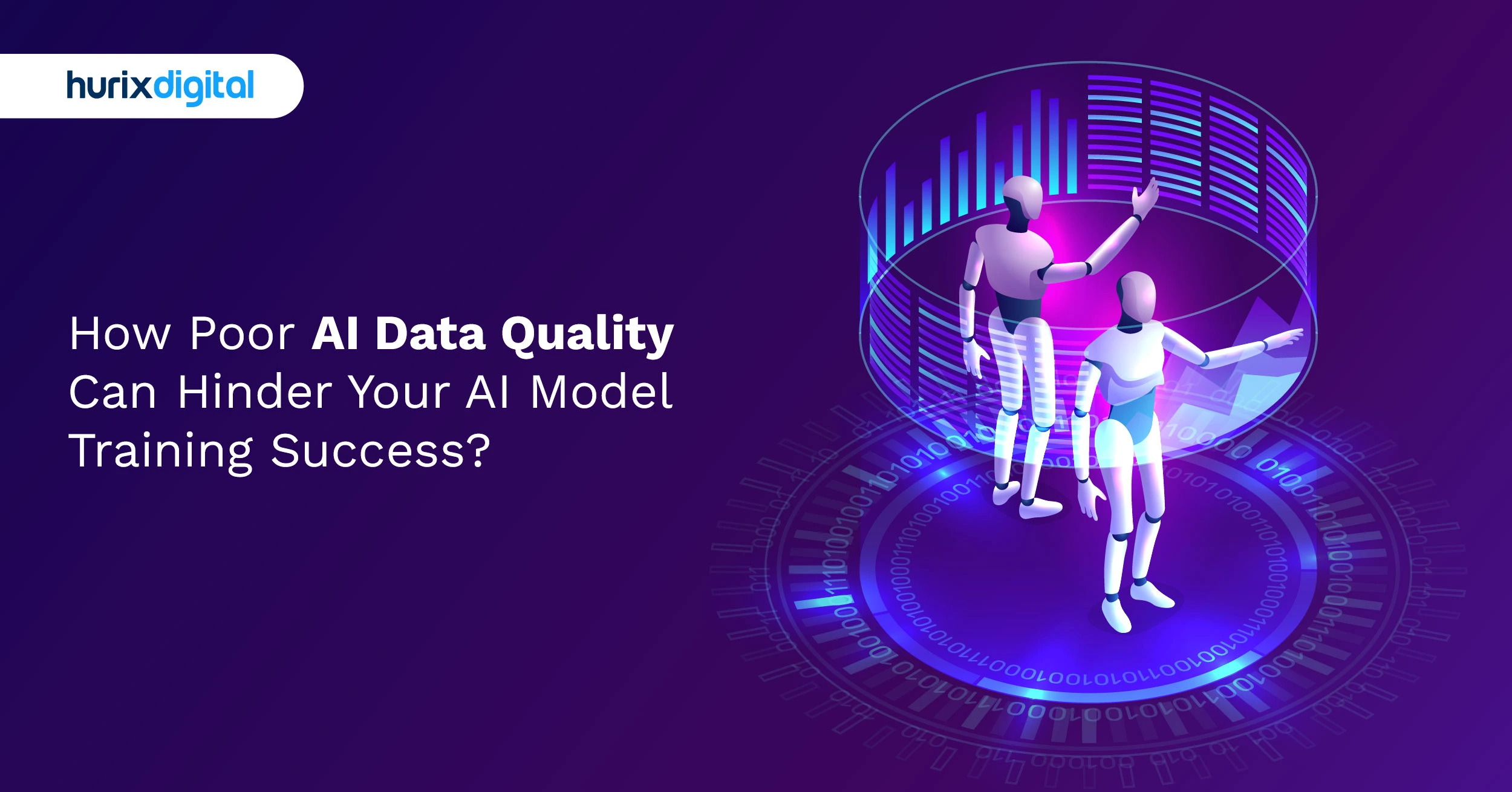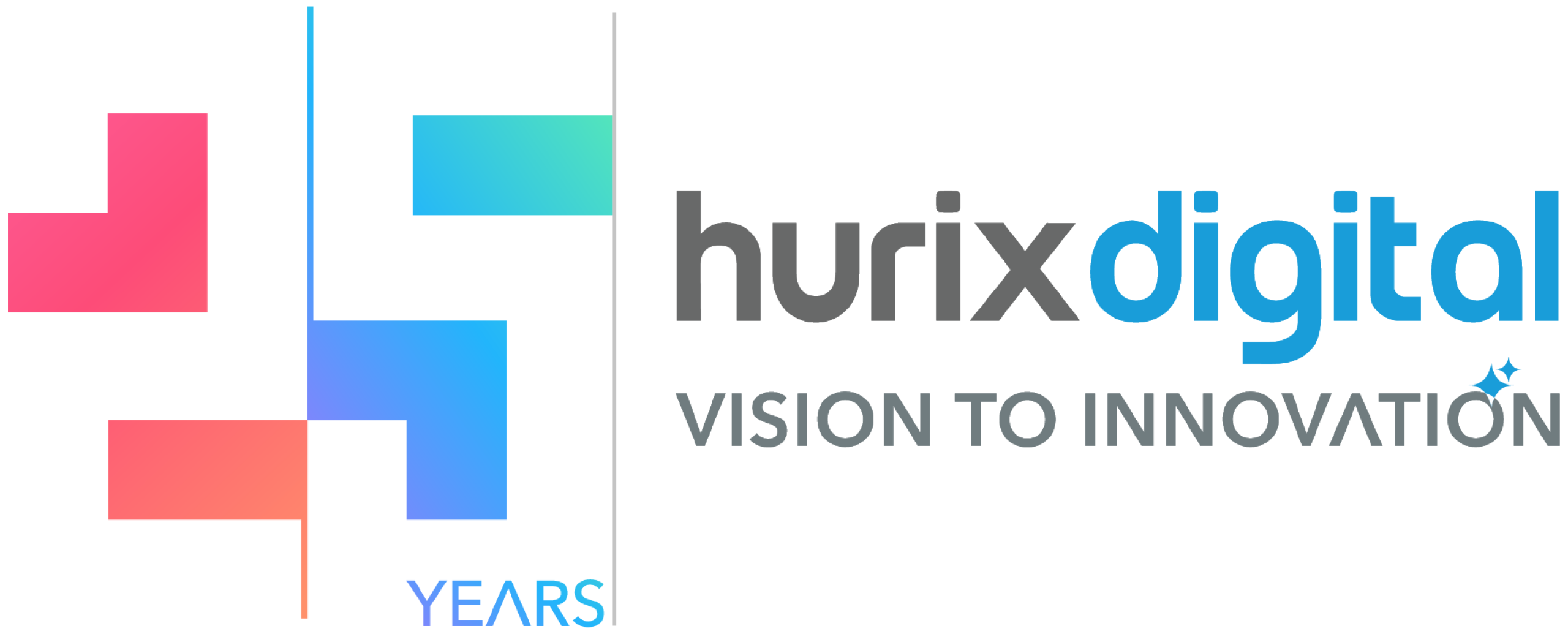
How Poor AI Data Quality Can Hinder Your AI Model Training Success?
Summarize with:
Remember when everyone thought AI was just science fiction? That was maybe five years ago. Now every company, from Silicon Valley startups to traditional manufacturers, is in a quest for its own AI. The boardroom conversations have shifted from “Why AI?” to “Why isn’t our AI performing better than the competition’s?”
Here’s what typically happens. A company learns about an AI chatbot or another AI breakthrough. The CEO gets excited. The CTO gets a mandate. Six months and several million dollars later, they have a model that works well in the lab but falls apart when real users interact with it. Sound familiar?
The gap between AI ambition and AI reality primarily stems from the training process. Not the kind where you feed data into algorithms and hope for the best. As with employees, models need the right environment, clear guidance, and constant feedback to be successful. Get it wrong, and you’re burning money on digital incompetence.
Articles published these days about AI training read like technical manuals. They’ll tell you about epochs and learning rates, and validation splits. Important stuff, sure. However, they overlook the complex reality of building AI systems that can withstand interaction with the real world. The midnight debugging sessions. The biases hiding in your data. The stakeholders who want magic but give you garbage inputs.
Let’s discuss what truly matters when training AI models. Not the theory, but the practice. The things experienced teams know but rarely document. The mistakes that cost millions could be avoided with some honest guidance.
Table of Contents:
- How to Eliminate Bias and Ensure Good AI Data Quality During AI Training?
- How to Align AI/ML Training with Strategic Business Goals?
- How Do You Ensure High-Quality Data for Effective AI/ML Training?
- What Infrastructure Best Supports Scalable and Efficient AI Training?
- How to Ensure Model Explainability and Build AI Trust for Stakeholders?
- What are the Best Practices for Continuous AI Model Performance Monitoring?
- How to Implement Robust Ethical AI Guidelines and Governance Frameworks?
- How to Address Skill Gaps and Build a High-Performing AI Team?
- What Strategies Optimize AI Training Costs Without Sacrificing Performance?
- How to Secure Sensitive Data and Ensure Privacy in AI Training?
- What are the Best Practices for Seamless AI Model Deployment and Integration?
- How to Effectively Measure AI Training ROI and Business Impact?
- Final Thoughts
How to Eliminate Bias and Ensure Good AI Data Quality During AI Training?
Every AI model inherits the sins from its training data. Feed it biased information, and it becomes a machine that amplifies bias. The recruiting AI that learned to reject women’s resumes was trained on historical hiring data from a company with a male-dominated workforce. The healthcare model that couldn’t diagnose conditions in Black patients was trained on datasets from predominantly white populations.
AI data quality control starts before training begins. One of our financial domain clients now spends two months validating data before touching any algorithms. They check for temporal consistency (did collection methods change over time?), demographic representation (who’s missing?), and hidden correlations (what’s accidentally predictive?). Boring work, but it prevents disasters.
Data cleaning isn’t glamorous either. Engineers want to build models, not fix typos in databases. Yet the tedious stuff matters most. Missing values create shadows where bias hides. Inconsistent formats teach models that variations are meaningful when they’re just sloppy record-keeping.
The best teams build bias testing into their workflow. They maintain “challenge datasets” specifically designed to expose discrimination. They run counterfactual analysis. What happens if we change just the gender or race variables? They bring in external auditors who are unfamiliar with the model’s development and ask them to break it.
How to Align AI/ML Training with Strategic Business Goals?
Start simple. Write down one stubborn business problem per division.
E-commerce faces fake orders, insurance has slow quote replies, retail loses sales from abandoned carts, manufacturing deals with machine breakdowns, and support often misses deadlines. Prioritize these by three easy factors: how valuable, doable, and quick the results are.
McKinsey’s survey work shows that organizations move faster when they pick a few high-potential use cases and attach learning to them, rather than offering generic courses in isolation. In 2024, firms reporting meaningful gains concentrated on targeted applications and built skills programmatically around those use cases.
Then translate each business problem into a short competency map. Fraud example:
- Analysts: Feature thinking, sampling basics, ROC/PR curves, segment evaluation.
- Engineers: Data pipelines, model registry, deployment checks, monitoring for drift.
- Leaders: ROI framing, risk controls, and change management with frontline teams.
This map becomes your curriculum spine. The NIST AI Risk Management Framework helps here. It forces a lifecycle view with four key steps:
- Govern
- Map
- Measure
- Manage
The framework nudges teams to think ahead. You document context first. You identify risks early. And then you also define success metrics before anyone opens a notebook. It is voluntary guidance, yet widely used because it’s practical and vendor-neutral.
How Do You Ensure High-Quality Data for Effective AI/ML Training?
Great models start with boring, well-described tables. Two practices raise the floor quickly:
- Document the Data: “Datasheets for Datasets” and “Data Statements” are simple templates that force teams to record origin, collection context, licensing, known gaps, and appropriate use. They emerged from real failures where models underperformed on underrepresented groups. Teams that adopt them catch issues earlier and respond to auditors more efficiently.
- Track Quality Beyond Nulls: Treat completeness, accuracy, timeliness, and consistency as separate checks, then automate tests in pipelines. When training and serving don’t match, you get the classic “skew.” Google’s “Rules of ML” and the “Hidden Technical Debt” paper both warn that silent mismatches are where systems rot. Build tests that run every time data moves.
Round out the hygiene with drift watching. Data drift and concept drift degrade a model quietly. You can start with distribution checks and a handful of statistical tests, then add specialized tools as you mature. The definitions are settled: data drift refers to a change in inputs, while concept drift refers to a change in the input–target relationship. Libraries such as NannyML or Alibi-Detect can help, but the main win is agreeing on alert thresholds and playbooks before things break.
Finally, be mindful of privacy law. If personal data is involved, GDPR’s data minimisation principle says keep information “adequate, relevant and limited to what is necessary,” and HIPAA defines strict rules for health data access and use. Mask, tokenize, aggregate, or synthesize where possible, and document why each field exists.
What Infrastructure Best Supports Scalable and Efficient AI Training?
Infrastructure decisions made in the prototype phase will haunt you at scale. That laptop GPU that trained your proof-of-concept? It won’t handle production workloads. The cloud credits seemed generous. They’ll evaporate when you start training on real datasets.
Most teams learn this the expensive way. A healthcare startup with which we were in talks burned through its annual computing budget in three months because it didn’t optimize its training pipeline. Every experiment ran on maximum resources “just to be safe.” Nobody monitored actual utilization. Data loading was consuming the remaining GPU time allocated to their models.
Hybrid approaches often work best. Keep sensitive data on-premise but burst to the cloud for training runs. Use spot instances for experimentation, but reserved capacity for production training. Storage architecture matters more than most teams realize. Training data needs to flow continuously to keep GPUs fed. Network-attached storage that seemed fast enough for development can create bottlenecks at scale. Local SSD caches help, but then you have to manage data synchronization. There’s no perfect solution, only trade-offs.
Container orchestration sounds like overengineering until you’re managing dozens of experiments across multiple teams. Kubernetes might be overkill for your first model, but by model ten, you’ll wish you’d started with it.
How to Ensure Model Explainability and Build AI Trust for Stakeholders?
“The AI said so” doesn’t fly in boardrooms anymore. Executives who wouldn’t dream of making million-dollar decisions based on black boxes are suddenly supposed to trust neural networks they can’t understand? Not happening.
The push for explainability comes from two directions. Regulators want to know why loans get denied or diagnoses get made. Business leaders want confidence that models won’t embarrass them. Both groups are right to demand transparency, but delivering it is harder than vendors admit.
Traditional models were interpretable by design. Linear regression shows exactly how each input affects the output. Decision trees reveal their logic path by path. Then deep learning arrived and traded interpretability for performance. Now we have models that work brilliantly but can’t explain themselves. The temptation is to choose simple models just for explainability. Bad move. A complex yet accurate model with approximate explanations outperforms a simple yet incorrect model every time.
Different stakeholders need different explanations. The data scientist wants feature importance scores and partial dependence plots. The product manager needs to know which user behaviors trigger recommendations. The executive wants assurance that the model aligns with the business strategy. The regulator wants proof of non-discrimination. One explanation rarely satisfies everyone.
Building trust requires more than technical explanations. It needs demonstrated reliability over time. We helped one insurance company develop monthly “model review boards” where AI teams present performance metrics, failure cases, and improvement plans. Stakeholders see the process, not just outcomes. They understand limitations because they’re discussed openly.
Documentation helps, but only if people read it. Better to build explanations into the product. That loan decision? Include a summary of key factors. The medical diagnosis? Show which symptoms drove the conclusion. Make transparency part of the user experience, not a separate report.
What are the Best Practices for Continuous AI Model Performance Monitoring?
Over time, models go bad, just like milk. The world changes, user behavior shifts, and suddenly your 95% accurate model drops to 85%. Or worse, it maintains accuracy on average while failing spectacularly on important segments.
Most teams discover model decay through customer complaints. The recommendation engine starts suggesting winter coats in July. The chatbot gives outdated information. The fraud detector flags every transaction from a new payment provider. By then, damage is done. Proactive monitoring requires defining degradation before it happens. What metrics matter? Accuracy alone is like measuring health by temperature alone. You need precision and recall broken down by user segments. Confidence distributions to spot when models become uncertain. Feature drift analysis to catch when inputs change.
One e-commerce company learned this after its search model’s performance mysteriously declined. Overall metrics looked fine, but dig deeper? Performance on new products tanked. The model trained on two years of data had never seen certain category combinations. As inventory evolved, predictions degraded. At our suggestion, they now monitor performance by product age.
Real-time monitoring beats batch analysis, but it’s harder to implement. You need streaming infrastructure, anomaly detection, and alerting systems. Start simple. Even daily batch monitoring beats finding out through customer support tickets. One team runs a “model health dashboard” that executives check like stock prices. A/B testing reveals what metrics miss. That new model with better test scores? Maybe users hate its recommendations. The only way to know is through controlled experiments.
Feedback loops hide everywhere. The model recommends products. Users buy them. The model learns that these are good recommendations. Soon, it only suggests bestsellers, creating a popularity spiral. Injecting diversity, exploration bonuses, or human curation are all effective ways to break these loops.
How to Implement Robust Ethical AI Guidelines and Governance Frameworks?
AI disasters are not prevented by ethics committees that meet quarterly. Operational integration is required for real governance; ethics must be incorporated into every decision, not just discussed in meetings.
The challenge starts with defining “ethical.” Fair to whom? Beneficial for what? A loan approval model that maximizes profit might harm vulnerable populations. One that prioritizes inclusion might lose money. There’s no universal answer, only organizational choices that need explicit articulation.
We helped one healthcare company build ethics into its development pipeline. Every model requires an “ethics impact assessment” before training begins. Who could be harmed? What biases might emerge? How will we detect problems? It’s like environmental impact studies for AI. Slows development? Yes. Prevents disasters? Also yes.
Governance structures must be stronger. Ethics officers who only advise are overlooked as deadlines near. Better models give ethics reps veto power, require sign-offs before deployment, or use automated checks to prevent bias. External views prevent echo chambers. Ethical companies involve community advisors, such as healthcare AI boards with patient advocates or hiring platforms that work with diversity groups.
Documentation requirements force thoughtful development. Every model requires a “model card” that explains its purpose, limitations, and potential harms. Sounds bureaucratic until you realize it prompts teams to think through the consequences. We helped one company identify three redundant models that solved the same problem differently because nobody had documented what existed.
How to Address Skill Gaps and Build a High-Performing AI Team?
Everyone wants to hire unicorns, PhD machine learning researchers who understand business well and can communicate brilliantly. Good luck finding one. Real AI teams succeed through the combination of complementary skills, not individual brilliance.
The skill gap starts with unrealistic expectations. Job posts require “10 years of TensorFlow experience” when TensorFlow is 8 years old! Demanding production experience with techniques published last month. Companies create impossible requirements and then complain about a talent shortage.
Successful teams blend backgrounds. The PhD who understands cutting-edge techniques but has never deployed production code. The engineer who can scale systems but lacks statistical knowledge. The domain expert who understands the problem but not the technology. Together, they build better solutions than any individual could.
Internal training beats eternal searching. That motivated developer who’s curious about ML? Probably a better investment than another recruiting fee. Remote work expanded talent pools dramatically. Why compete with Silicon Valley salaries when brilliant minds in Eastern Europe or South America cost half as much? Time zones create challenges, but documentation and asynchronous communication help.
Retention matters more than recruitment. AI talent has options. They’ll leave for better projects, not just better pay. The teams that keep people give them interesting problems, modern tools, and paths to growth. One company retained its entire AI team during a rough patch by allowing them to publish papers and attend conferences.
Cross-functional literacy prevents silos. Product managers don’t need to implement neural networks, but they should understand capabilities and limitations. Engineers don’t need MBAs, but they should grasp business constraints. Regular “AI literacy” sessions where teams explain their work to each other build shared understanding.
The best teams maintain learning velocity. Technology changes too fast for static skills. Budget time for experimentation. Encourage paper reading. Build prototypes with new techniques. The team that stops learning starts falling behind.
What Strategies Optimize AI Training Costs Without Sacrificing Performance?
Cloud providers love AI companies. All those GPUs spinning, all those storage buckets filling, all those egress charges adding up.
Smarter training schedules cut costs dramatically. One company reduced expenses by half by running experiments overnight on spot instances. Prices drop when demand is low. Yes, spot instances can disappear, but with checkpointing, you just resume later. The key is making interruption tolerable, not impossible.
Data efficiency beats computational brute force. Everyone wants bigger models trained on more data. But diminishing returns hit hard. That last 1% accuracy improvement might cost 10x more than the first 90%. Mixed precision training seems like a hack until you see the speedup. Using 16-bit floats where possible nearly doubles throughput on modern GPUs. The accuracy loss? Often negligible.
Transfer learning remains underutilized. It’s not ‘cheating’ to start with ‘pretrained’ models. Why train language understanding from scratch when models like BERT exist? Fine-tuning requires orders of magnitude less computation than training from random initialization. Monitoring utilization reveals waste. GPUs are sitting idle while loading data. Memory allocated but unused. CPUs are throttling on single-threaded preprocessing.
How to Secure Sensitive Data and Ensure Privacy in AI Training?
AI’s dirty secret? Models memorize training data. Feed them sensitive information, and they might regurgitate it later. The language model that outputs real credit card numbers. The healthcare AI that reveals patient details. Privacy violations waiting to happen.
Security starts with data governance. Who has access? How is it stored? What can be combined? One hospital thought they anonymized patient records by removing names. Then someone matched admission dates with public obituaries. Suddenly, “anonymous” wasn’t.
Differential privacy sounds academic until you need it. Adding carefully calibrated noise preserves population statistics while protecting individuals. Apple uses it for keyboard predictions. Google for Chrome statistics. The math is complex, but libraries make implementation feasible. One caveat: privacy guarantees come at the cost of accuracy. There’s no free lunch.
Federated learning keeps data distributed. Instead of centralizing information, train models where the data lives. Phones collaborate to improve keyboards without sharing typing. Hospitals jointly develop diagnostic models without exchanging patients. The approach adds complexity but enables collaboration previously impossible for privacy reasons. Access controls need enforcement, not just policies. That contractor who left six months ago? They might still have data access.
Model attacks are real. Membership inference reveals if specific data was in the training sets. Model inversion reconstructs training examples. Adversarial examples intentionally fool models. Defense requires assuming models will be attacked and building accordingly.
Compliance keeps getting stricter. In the context of GDPR, the “right to be forgotten” presents challenges. How can you remove someone’s data from a trained model? CCPA adds California-specific requirements. Healthcare has HIPAA. Finance has PCI. Every industry has acronyms that translate to “protect data or pay penalties.”
What are the Best Practices for Seamless AI Model Deployment and Integration?
The graveyard of AI projects is full of models that worked perfectly in Jupyter notebooks. They had impressive accuracy scores, beautiful confusion matrices, and compelling presentations. Then deployment day arrived, and everything fell apart.
Production is different from development in ways that surprise even experienced teams. Is that model taking 30 seconds to generate predictions? It’s fine for batch processing but deadly for real-time applications. And the preprocessing that assumed sorted inputs? Production data arrives chaotically. Every assumption breaks eventually.
API design determines adoption. Data scientists think in dataframes and tensors. Applications speak JSON and REST. The translation layer matters. One team spent months building a brilliant model that nobody used because the API required matrix inputs. Rebuilding with business-friendly interfaces took weeks but enabled adoption. Monitoring in production differs from development metrics.
Integration testing catches interdependency failures. Your model expects normalized inputs. The upstream system changed normalization. Nobody told anyone. Production breaks. Comprehensive integration tests would have caught this.
How to Effectively Measure AI Training ROI and Business Impact?
Return on investment (ROI) calculations for AI make executives nervous. Traditional IT investments have clear inputs and outputs. Spend X on servers, save Y on processing. AI is fuzzier. Spend X on GPUs and data scientists, get… what exactly?
The mistake is measuring technology metrics instead of business outcomes. Model accuracy doesn’t pay bills. Customer satisfaction does. Conversion rates matter. Cost reductions count. Baseline establishment is often overlooked in the excitement. How did the process work before AI? What were the costs? The error rates? Without baselines, improvements are guesses.
Time horizons complicate measurement. AI investments front-load costs, including infrastructure purchase, team building, and data preparation. Benefits arrive later and accumulate gradually. Quarterly earnings calls don’t appreciate this timeline. Smart organizations expect to invest now and reap the benefits later.
Hidden benefits matter more than direct ones. The fraud detection model directly saves money. However, it also enhances customer trust, reduces manual review workload, and provides data for informed business decisions. Capturing these second-order effects reveals true value. Failed experiments provide value, too. That model that didn’t work? It revealed AI data quality issues. The approach that failed? It eliminated a research direction. Organizations that only count successes undervalue learning.
Competitive advantage resists quantification. Being first with AI-powered features might define market position for years. How do you value that? One approach: estimate the cost of falling behind. What would matching competitors later cost? The defensive value of AI investment often exceeds offensive gains.
Attribution challenges multiply with scale. Which AI investment drove which improvement? Was it the recommendation engine or the better search? The fraud detection or the customer service bot? Simple attribution models break down. It is better to measure the portfolio impact than the individual model ROI.
Final Thoughts
Years of watching AI projects succeed and fail teach hard lessons. The technology is powerful but unforgiving. Small mistakes compound into large failures. Biased data creates discriminatory systems. Poor infrastructure wastes millions. Weak governance invites disaster.
However, when done correctly, AI can transform organizations. Not through magic or automation apocalypse, but by augmenting human capabilities. The fraud analyst who catches 10x more cases with AI assistance. The doctor who diagnoses rare conditions with AI support. The teacher who personalizes education with AI tools.
Organizations that thrive with AI share characteristics. They obsessively invest in AI data quality, build teams that blend technical and domain expertise, govern development with clear ethical frameworks, and measure success by business outcomes rather than technical metrics. Most importantly, they learn from failures instead of hiding them.
Years of AI success come from mastering data, infrastructure, and governance. For trusted, scalable AI data solutions that empower your organization, partner with Hurix.ai. Discover how precision and ethics can transform your AI.
Visit us to get started today!
Summarize with:

Vice President – Content Transformation at HurixDigital, based in Chennai. With nearly 20 years in digital content, he leads large-scale transformation and accessibility initiatives. A frequent presenter (e.g., London Book Fair 2025), Gokulnath drives AI-powered publishing solutions and inclusive content strategies for global clients
 A Space for Thoughtful
A Space for Thoughtful 